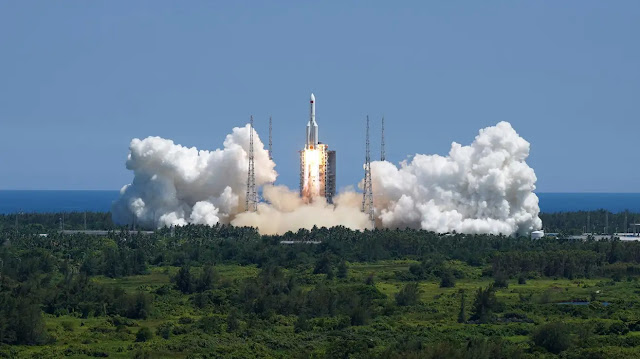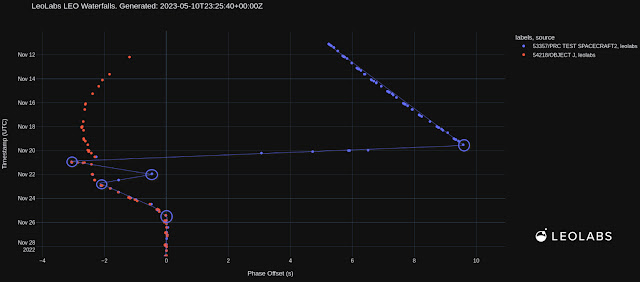CASC - China Aerospace Science and Technology Corporation logo.
May 11, 2023
This reusable machine could become one of the spearheads of Chinese space logistics.
Chinese Spaceplane Returns To Earth After Longest Flight So Far
In a (very) brief statement from the government news agency Xinhua, the Chinese space agency announced that its mysterious reusable space plane had finally returned to the fold. It thus completes its second consecutive orbital mission after having spent 276 days in orbit.
“The success of the experiment marks an important advance in Chinese research on reusable space vehicles, which will provide more practical and economical methods of using space peacefully,” explains the press release spotted by Space.com.
The wording suggests that the craft has achieved all of its goals. But unfortunately, it is more or less impossible to determine what the purpose of this mission was. The agency never revealed exactly what kind of system it intended to test with this device. And she was just as discreet about her return.
Image above: China’s spaceplane launched from the Jiuquan Launch Center aboard a Long March 2F rocket in August 2022. Photo Credit: LIU HUAIYU (AP).
Paradoxically, this relative discretion generated a certain feverishness, particularly on the side of the United States. Uncle Sam closely follows China's every move in the context of their political and economic rivalry, and several American institutions have therefore tracked the device.
The army notably estimated that the one which vaguely resembles the Boeing X-37, was flying at an average altitude of 600 km. He took advantage of his stay to perform a lot of various and varied orbital maneuvers.
The US Army also observed that the craft had released an object of unknown nature into orbit on October 31. It could be a small cubesat serving a science program. But given that he remained close to the plane for most of the flight, it is more likely that he was involved in testing some main vehicle systems.
The embodiment of Chinese aerospace progress
Impossible to know more in the absence of official confirmation. The only point that seems clear is that it is a test vehicle that must contribute to the development of a new generation of reusable ships.
This is an eminently important point in modern aerospace. Indeed, this approach standardized by SpaceX makes it possible to achieve substantial savings in time, resources and money. Most major operators are in the process of conforming to this new paradigm, which is now essential to be part of the global elite of aerospace.
Until very recently, the American contingent exercised unchallenged domination at this level thanks to Elon Musk's firm. But at the moment, China is also progressing more and more rapidly in this segment.
Since the inaugural flight of the CQQHQ, the very first Chinese reusable launcher prototype which saw the light of day in 2020, Xi Jinping's country has notably acquired a new reusable version of its Long March 8 Y2 rocket. These efforts also concern the private sector. Lots of young Chinese shoots are actively contributing to this new space race. And that's probably just the beginning.
It will therefore be interesting to observe the evolution of this still mysterious machine. Within a few years, it will likely play a significant role in China's orbital logistics. It could, for example, facilitate the deployment of satellite constellations or the sending of equipment to Tiangong, its brand new space station.
Tiangong, the Chinese space station. Image Credit: CNSA
On a larger scale, it will also be necessary to remain attentive to the fallout from this space showdown between superpowers. Knowing the strategic, political and economic stakes of this industry, it seems obvious today that this theme will condition an increasingly important part of international relations. Let us therefore hope that Europe will also be able to put forward its arguments, even if the Old Continent is currently lagging considerably behind.
China’s spaceplane conducted proximity and capture maneuvers with subsatellite, data suggests
China’s secretive spaceplane may have performed multiple recaptures of an object it released into orbit during its recently completed second flight as part of on-orbit testing.
Private firm Leolabs, which provides space situational awareness data through its global network of radars for tracking objects in low Earth orbit, said its analysis found evidence of what appeared to be at least two and possibly three capture/docking operations with a co-orbiting object.
Image above: Maneuvers of China's spaceplane and companion subsatellite in November 2022, tracked by Leolabs. Image Credit: Leolabs.
U.S. Space Force’s 18th Space Defense Squadron tracking data revealed an object in a closely-matching orbit to the spaceplane Oct. 31, 2022 (NORAD ID 54218 (2022-093J COSPAR ID)).
This companion subsatellite was then used in a series of rendezvous and proximity operations (RPO) with the spacecraft, according to Leolabs.
“Analyzing data from our global radar network, we’ve determined that the Test Spacecraft2 has propulsive capability and engaged in proximity operations with Object J, including what appeared to be at least two and possibly three capture/docking operations,” a Leolabs statement said.
Leolabs’ assessment of on-orbit activities highlights three periods of RPO. One period, between Nov. 25 and Dec. 24 last year, shows that the two spacecraft were either docked or spaced very closely, with a possible docking performed on Nov. 25 or 26. A second docking was noted as taking place Jan. 10, 2023, in a second phase of operations.
A later phase, between Feb. 20 and March 29, was similar to the previous and “featured what appeared to be apparent forced separation, followed by rendezvous and formation flying. 54218 [companion satellite] was once again observed to maneuver independently of the parent craft.”
Leolabs notes that, on a minimum of five occasions, the companion satellite demonstrated what appeared to be independent propulsive capabilities.
Leolabs on Twitter
The spaceplane’s operations will likely gain attention outside of China, particularly with regards to docking and capture operations and the possible uses of such capabilities.
“Based on what we do know, it seems like the Chinese and American spaceplane programs are being used in very similar fashions – primarily as testbeds for new technologies and capability demonstrations. It’s hard to tell for sure what technologies or capabilities exactly, as both governments are pretty secretive about the details,” Brian Weeden, director of program planning for the Secure World Foundation, told SpaceNews via email.
“What I find fascinating is the perceptions surrounding each program. When the X-37B started flying, it generated a lot of concern from the Chinese about the potential for it to be used as a weapon, a concern they’ve mentioned in recent multilateral discussions on space security.
“Likewise, I expect that these latest reports on the Chinese spaceplane are likely to cause a lot of concern in the US, despite it being pretty similar to capabilities the U.S. is also developing.”
A statement from the spaceplane’s maker, CASC, released after the May 10 landing claimed that the project “will provide a more convenient and inexpensive way to access space for the peaceful use of space in the future.”
“We know the X-37B has also deployed several subsatellites on previous missions, but there isn’t the public tracking data to be able to tell if it did RPOs or not,” Weeden wrote.
The spacecraft landed at Lop Nur military base in Xinjiang May 8. Leolabs states that their observation data indicated the landing window to be likely between 0018 and 0020 UTC.
CASC’s reusable spaceplane project last year acquired national level funding from the Natural Science Foundation of China.
Leolabs previously highlighted that the spaceplane made a large change to its orbit in April, likely in preparation for the spacecraft to land. The mission was used by the company to test its capabilities.
“This event tested LeoLabs object tracking and maneuver detection and characterization capabilities, proving that we can provide critical intelligence on the behaviors and activities of HIOs thanks to our continuous, real-time operations,” Leolabs said in a statement.
Related articles:
China’s mystery spaceplane releases object into orbit
https://orbiterchspacenews.blogspot.com/2022/11/chinas-mystery-spaceplane-releases.html
China makes progress in reusability with secretive third flight of spaceplane
https://orbiterchspacenews.blogspot.com/2022/08/china-makes-progress-in-reusability.html
2nd launch of China Reusable Experimental Spacecraft
https://orbiterchspacenews.blogspot.com/2022/08/2nd-launch-of-china-reusable.html
China’s Reusable Experimental Spacecraft
https://orbiterchspacenews.blogspot.com/2020/09/chinas-reusable-experimental-spacecraft.html
Related links:
China Aerospace Science and Technology Corporation (CASC): http://english.spacechina.com/n16421/index.html
Natural Science Foundation of China: https://www.nsfc.gov.cn/english/site_1/index.html
Leolabs: https://leolabs.space/
Images, Text, Credits: CASC/AP/Leolabs/Space.com/Orbiter.ch Aerospace/Roland Berga.
Greetings, Orbiter.ch






